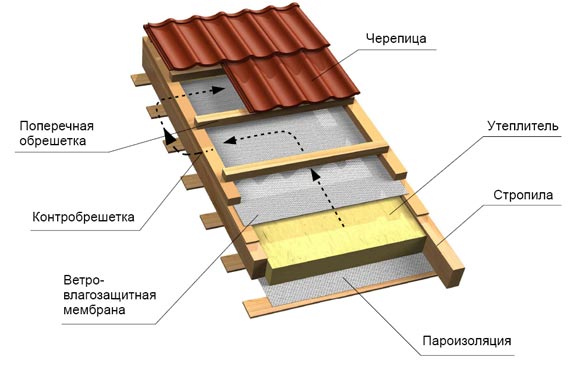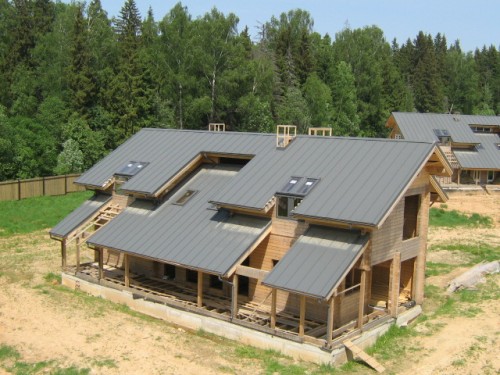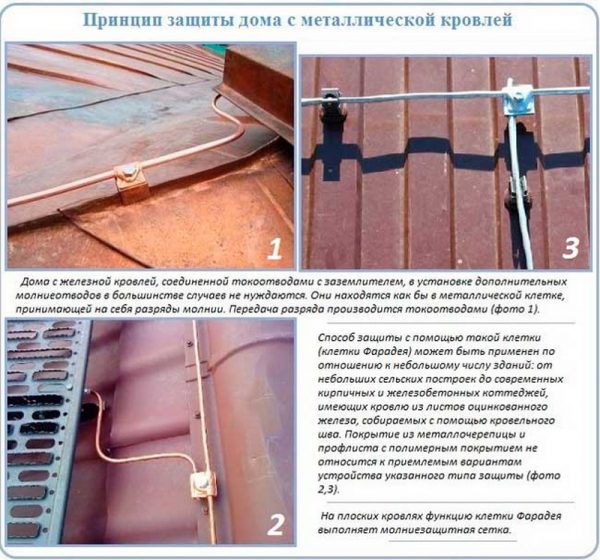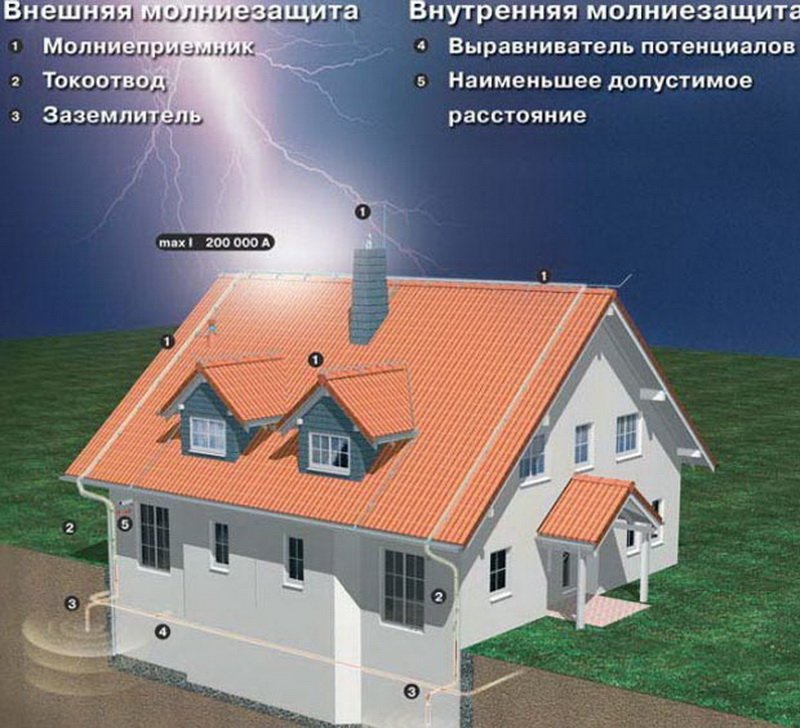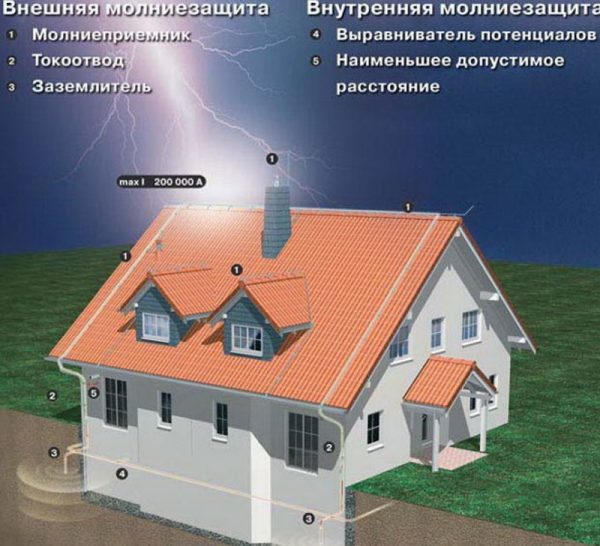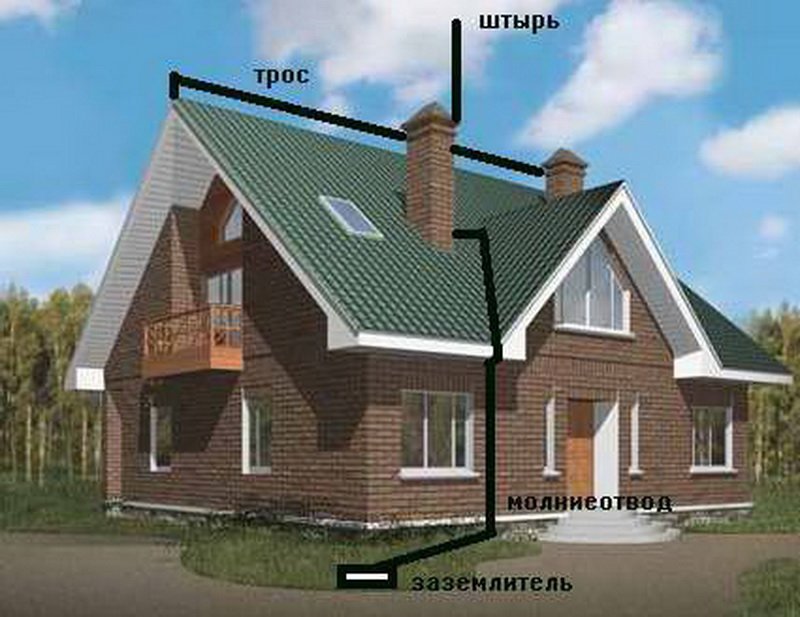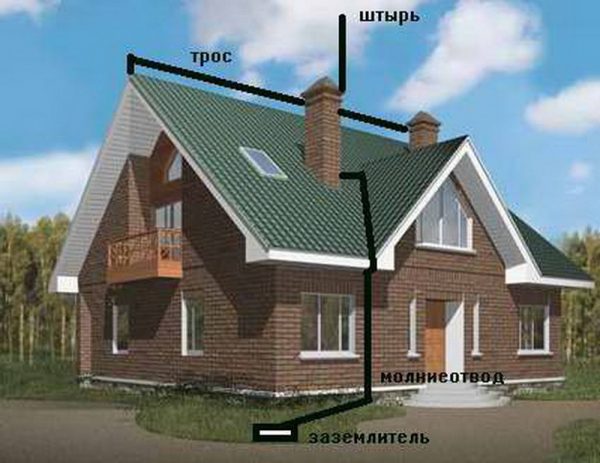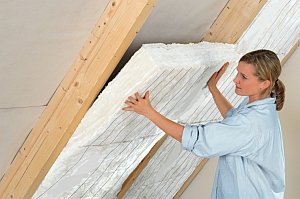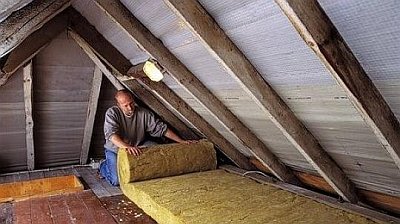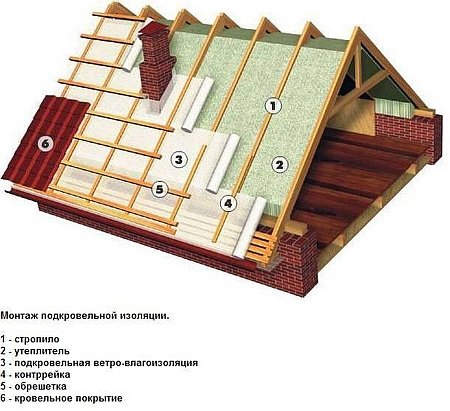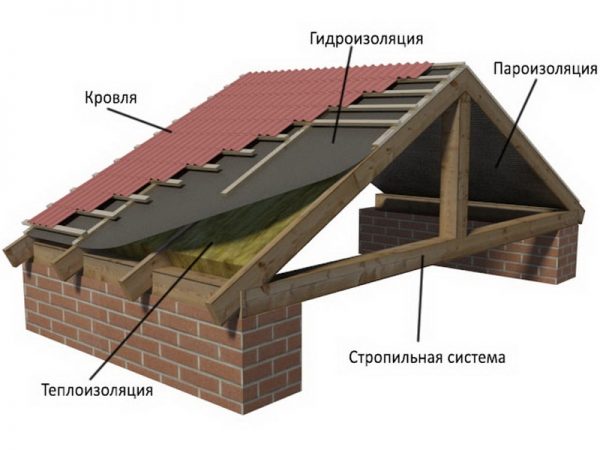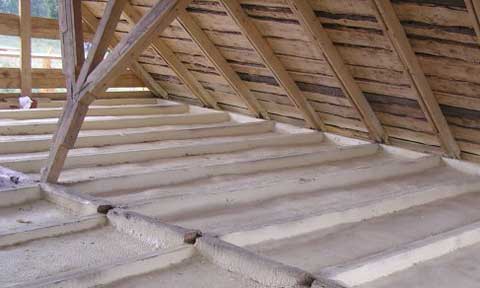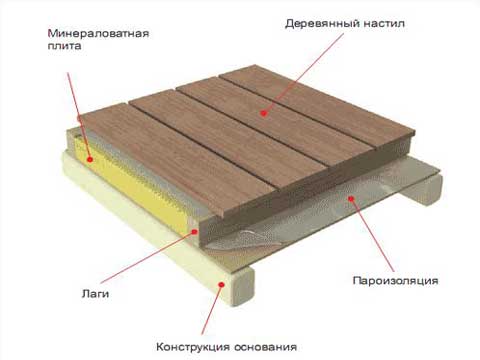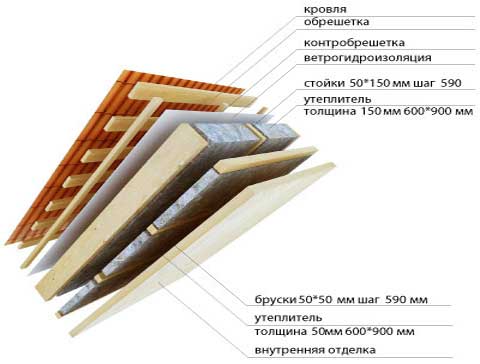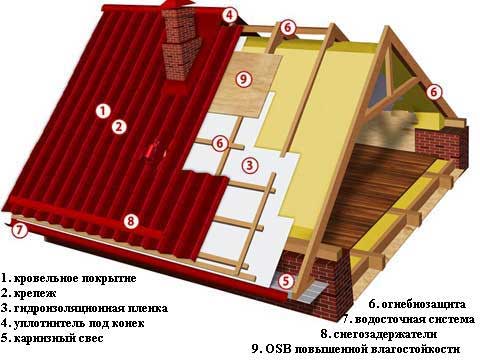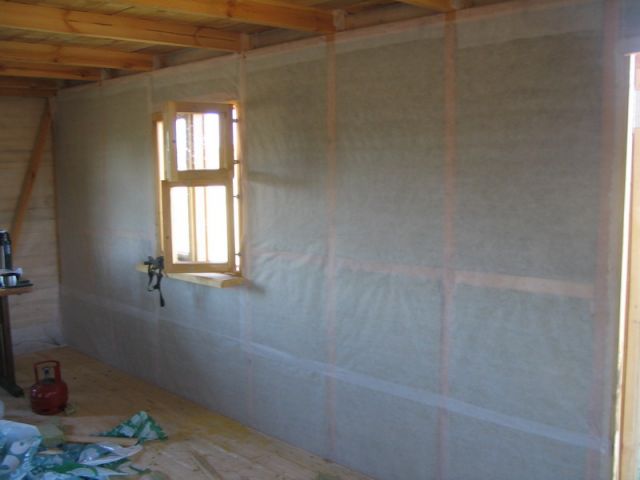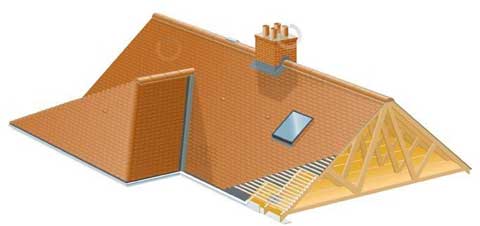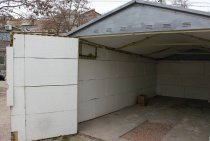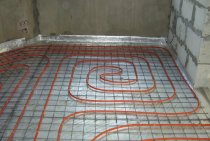Roof preparation
Scheme of installation of insulation.
When insulating the roof with your own hands, first of all, you need to draw up a work plan and decide on thermal insulation materials. Any roof, regardless of the type of construction, consists of an external and internal part. The roof from the outside (from the street) is called the roof, and the inside is made up of a frame of rafters and floor slabs. In order for the roof to be warm and last for a long time, before starting work, if necessary, it is necessary to carry out repair work, get rid of moisture and all its manifestations on the roof structure: rust, fungus or mold. In this case, the metal parts are cleaned with a metal brush and coated with anti-corrosion agents, and areas affected by mold or fungus are treated with antiseptic compounds.
Regardless of the type of roof, in the absence of insulation, the heat loss of a house can be 25%
Based on this, it is important to choose a suitable thermal insulation material. To simplify the installation of insulation with your own hands, the width of the plates must correspond to the distance between the rafters
Otherwise, cold zones will form in unfilled areas, which will lead to a decrease in the quality of the insulation structure. If you use roll insulation (instead of slab insulation), then you can set any width by cutting the roll with a conventional wood saw. This will be true if the distance between the rafters is different. To keep the roof warm, today there is a wide selection of heaters. Each of them has its pros and cons:
Scheme of a pitched roof with insulation.
- Glass wool is relatively cheap, easy to install, and has good thermal insulation characteristics. It must be used in conjunction with waterproofing, as it can lose up to 60% of its thermal insulation properties when wet. It is not a favorable environment for the life of rodents and insects.
- Mineral wool - similar in characteristics to glass wool, but has a long service life (up to 50 years). It is very convenient for do-it-yourself installation, as it is available in rolls or in the form of plates.
- Basalt slabs - the main advantage of this insulation is high fire resistance. When wet, it loses its thermal insulation properties, therefore, like other fibrous insulation, it should be protected from moisture.
- Styrofoam is one of the cheapest, but no less effective heaters. The variety of slab sizes allows it to be used for any roof construction. The disadvantage is the fragility of the plates, so you need to be careful during installation. In this case, the roof can become a habitat for rodents when using foam as a heater.
- Expanded clay - the main advantage is the environmental friendliness and fire resistance of the material. At the same time, it is biologically resistant. But the application technology mainly applies to horizontal surfaces (roof floors, ceilings), which limits its use. It is also heavier than mineral wool.
- Polyurethane foam is a liquid insulation with a rather low thermal conductivity. It is applied by spraying onto the prepared waterproofing layer. Suitable in cases where you need to quickly carry out warming measures.
Icing on the roof
As practice shows, snow on the roof does not pose any danger, except for additional weight on the roof frame. The danger from snow appears when it begins to melt, as a result of which ice forms.
Do-it-yourself warming
And because of the ice, icicles and ice plugs appear in the drainage systems. In addition, frost adversely affects the quality of the roofing. And this is not the only unpleasant moment for the roof.
The main reason for the formation of ice is the temperature difference between day and night. In parallel, the melting of snow occurs from the transfer of heat from the living quarters to the attic, and from it to the roof.
For this reason, a warm roof warns against all these problems. Although much depends on the material with which the roof is covered.
At this temperature, the air contains a small percentage of moisture, which completely eliminates the possibility of precipitation. And, if there is no precipitation, then there is nothing to form ice from.
Roof lightning protection
Speaking about roof insulation, one cannot but touch upon such an aspect as lightning protection. Whatever the strong covering material with a super-protective layer, lightning is quite capable of burning through it. And since it is laid on a wooden crate, melting and burns can cause a fire. Therefore, the creation of protection to intercept the lightning discharge and redirect it to the ground is necessary.
Houses with a metal roof do not need to install lightning rods, for them it is enough to provide a down conductor made of thin steel wire and its grounding
Lightning protection device
There are two types of lightning protection - internal and external. Internal protects all electrical appliances in the house from overvoltage. The cheapest and easiest way to internal protection is to turn off the electricity in the house or at least electrical appliances from energy sources during a thunderstorm. External lightning protection is designed to meet a lightning discharge at the roof, conduct it along a safe path (down conductor) and neutralize it in the ground.
Internal lightning protection protects electrical appliances from overvoltage, and external protects the roof from lightning and possible melting of the covering material
The scheme of external lightning insulation is quite simple. It is easy to make it yourself with the help of a gas apparatus and clamps for fixing the down conductor.
The lightning protection system has a not very complicated device, so you can easily and quickly make it yourself
Such a protection system consists of the following elements.
- Lightning rod (lightning rod) - "bait" for lightning in the form of a galvanized, copper or aluminum pin with a diameter of approximately 12 mm and a height of 0.2–1.5 m, installed at the highest point of the roof. You can replace the pin with a lightning rod - relevant for flat roofs - or with a metal cable laid along a ridge ridge.
-
Down conductor - a charge conductor from the lightning rod to the ground electrode, made of steel wire Ø 6 mm, descending from the roof along the walls of the building and fixed with clamps or brackets.
-
Grounding conductor - a device that provides contact of the conductor with the ground. This can be a welded structure made of angle bars and pipes buried in the ground, a metal barrel, a sheet of iron, or steel reinforcement driven into the soil. For effective operation of the earth electrode, it is necessary that the soil around it is wet. Therefore, it is recommended to periodically moisten it with water during a drought, and it is even better to bring drains to this place.
Every year, before the start of the rainy season, it is necessary to inspect the lightning rod, checking all fasteners. Loose fasteners should be tightened. Once every 5 years, it is necessary to open the grounding device and check it for the depth of corrosion. If rust has covered ⅓ of the ground electrode, then it must be replaced.
Video: do-it-yourself lightning rod, a budget option
In this article, we looked at the issues of roof insulation so that you can navigate the variety of materials that exist today to solve this problem. But you need to understand that even the perfect insulation of the roof structure will not give the desired effect without suitable protection of the foundation, walls, floors and ceilings. Only a set of isolation measures will create really comfortable conditions for living in the house. Good luck to you.
The need for roof insulation
How to make the roof warmer to significantly reduce heat loss at home? First of all, you need to choose the right insulation materials and definitely stick to the installation technology. A well-insulated roof increases the thermal efficiency of the house by 15%, makes it possible to make an attic into a room suitable for a year-round residence.
Particularly great demands are placed on the heat insulator of the roof of the attic of a residential type of houses located in areas with cool winters.. The cake of the roof of summer attics or used attics includes a thinner insulation layer. The roof, under which an unused attic is located, in most cases is not insulated - thermal insulation is installed on the attic floor or ceiling of residential premises. Not a warm non-residential attic is perfectly ventilated, which prevents the elements from the wood of the roof frame from rotting.
When installing pitched and flat roofs, various options for roof insulation are used.
Thermal insulation of a pitched roof
The pitched roof pie is created with insulation along the rafters
It is important to figure out how to properly insulate the roof of the house, so as not to allow oversights, which eventually lead to damage to wooden structures.
Mineral wool is considered the most famous insulation in private housing construction. This is a non-combustible material that is easy to install, which you can buy at a low cost. But the very design of the fleece helps the accumulation of moisture, which is the reason for a significant decrease in the quality of the thermal insulation of the material, and even after some time it incites the rotting of the components of the rafter system
Similarly, when creating insulation, it is important to provide for proper ventilation and waterproofing and vapor barrier of the roofing pie.
Installation of a pitched roof heat insulator is created from the side of the attic in construction work or roof repair. If repair work is underway, before laying the insulation, you need to check the condition of the rafters - rotting parts must be replaced with new ones. It is also worth finishing all wooden structures with a fire-retardant composition.
Pitched roof pie includes:
- final covering for a roof;
- hydrobarrier (a layer of material for waterproofing works);
- heat insulator;
- vapor barrier;
- trim inside (optional).
Proper thermal insulation of the roof requires good air exchange, for which you need to make air layers between:
- under-roof waterproofing and roof coating;
- insulation and hydrobarrier;
- vapor barrier and inner lining (if provided).
Air circulation (removal and free inflow) is supplied by specialized air ducts, one of which must be located in the roof overhang, and the second - under the ridge.
Types of roof insulation of a modern house
The final stage in the construction of a box of any structure is the arrangement of the roof, the quality installation of which determines the comfort and coziness in the premises, as well as the durability of the entire building. A reliable roof over your head is the prevention of up to 30% of all building heat loss, insulation from internal condensate and precipitation. Important aspects of the durability and effectiveness of roofs are considered to be properly selected and laid protective layers - waterproofing, thermal insulation and vapor barrier.
In a roofing pie, each layer performs its assigned function, provided that they are placed in the correct order.
Each of them is located strictly in the place allotted to it and carries a certain functional load, on which the operational characteristics of the roof depend.
-
The waterproofing layer protects the under-roof space from the penetration of atmospheric moisture. It is laid along the outer edge of the rafters, fixed with counterbars and a crate. A significant condition for proper installation is the presence of a ventilation gap between the waterproofing and the insulation.
-
The heat-insulating layer is designed to protect the interior from summer heat and eliminate heat loss through the roof during the cold season. Insulation is laid between the rafter legs in such a way that its inner surface does not slightly reach the upper edge of the rafters, due to which a ventilation duct necessary for good ventilation of the roof is formed.
-
Vapor barrier membranes or films protect the insulation from warm and moist steam from the side of the room below. They are hemmed along the inner edge of the rafters and fixed with slats or finishing materials, such as clapboard, drywall, etc.
Mounting arrangement options
Insulation of an unheated attic
The simplest type of roof insulation device is the thermal insulation of an unheated attic, since the insulation of roof slopes is irrational. The most reasonable thing in this case is to carry out thermal insulation of the attic floor. Structurally, it is performed as follows:
- having attached a vapor barrier with an overlap from below to the lags, they create an obstacle to moving steam;
- place a heater between the lags;
- so that it is possible to move along the thermal insulation, either it is covered with a continuous flooring, or “paths” are laid from the boards.
Thermal insulation must be constantly dried, therefore, ventilation holes are provided in the gables, and waterproofing is installed under the roofing material to protect against possible leaks.
Insulation of a warm pitched roof
The thermal insulation of a used attic or residential attic is somewhat more complicated. The design of the insulation, which also includes the thermal insulation of the slopes, consists of the following:
vapor barrier
It is necessary to minimize the penetration of vapors from residential premises into the thermal insulation. The vapor barrier film consists of several layers of polyethylene in several layers and a reinforcing grid of polyethylene or polypropylene. Fastening is performed either with a stapler or slats.
It is important at the same time to glue the joints with construction butyl tape.
Particular attention when installing a vapor barrier requires junction points. They are also glued with butyl tape.
Roof insulation
Insulation of calculated thickness fills the space between the rafters
The calculations take into account the coefficient of thermal conductivity and the operating conditions of the pitched roof. Quite often, mineral wool acts as a heater (density - 30-50 kg / cu.
m) and staple fiberglass. For additional fastening of fibrous materials, stretch marks from fishing line or rope are also used. If the height of the rafters is not enough to lay the insulation of the required thickness, it is increased by additionally stuffing timber to the rafters.
Insulation waterproofing
The main function of this layer is protective: firstly, from leaks in the roofing, and secondly, from condensate that forms on some of its types. For waterproofing apply:
- a hydrobarrier made similarly to a vapor barrier made of PE layers with a reinforcing grid, with the difference that additional microperforations and cone-shaped punctures are made on it to remove steam. During installation, a gap of several centimeters is maintained between the thermal insulation and the hydrobarrier.
- superdiffusion membrane, the vapor permeability of which is very high in comparison with the film hydrobarrier. It is laid without any gaps directly on the heat-insulating layer.
ventilated gap
An air gap must be provided above the waterproofing layer for ventilation, through which steam is removed that escapes through the waterproofing from the insulation. The products are placed on the roof eaves and the ridge.
Roof substructure
As a rule, for laying roofing, it is necessary to equip the crate - solid or lattice with a certain step.
The choice of material for a cold roof
However, it is impossible to closely mount a heater to such a film. The fact is that when in contact with the insulation, the film loses its insulating properties and the insulation actually gets wet. So, if in the future it is planned to equip, insulate the attic or attic, it is better to use a waterproofing membrane.
When installing a cold roof, you can use as a cover all traditional materials that do not require a solid base. However, according to experts, the optimal solution is a profiled sheet or metal tiles, which are technological, durable and reliable roofing materials.
Steel profiled sheet
The simplest solution for a cold roof in the case of a non-residential building is the use of a steel profiled sheet provided with an anti-condensation coating. This material, which has the structure of synthetic felt, is applied to the reverse side of the profiled sheet directly during the manufacturing process.
Between the intertwined fibers of synthetic felt there are many tiny air cavities, due to which the coating accumulates and retains a certain amount of moisture (up to 1 l / sq.m). As the air temperature rises, it begins to evaporate intensively. In this case, there is practically no need for a counter-lattice or laying a waterproofing film.
The installation of a roof from a profiled sheet with an anti-condensation coating is carried out similarly to the installation of a conventional sheeting. For installation work, neither a specialized tool nor additional devices are needed. When using this material, a 30% savings on the cost according to the estimate is achieved.
The anti-condensation coating dampens the noise of wind, hail and rain, prevents the formation of mold and fungus, and is easily cleaned under pressure with water from contaminants.
2019 stylekrov.ru
vapor barrier
In any residential area, water vapor is necessarily present, which rises from the bottom up, falling as a result into the under-roof space, where the roof insulation is located. which must not be exposed to these vapors.
Therefore, a vapor barrier is a mandatory element that a roof and roof insulation must have. Finishing the walls of an attic or attic room with a material that does not allow vapors to pass through can sometimes prevent their penetration into the insulation, but most often it is necessary to use special vapor barrier films that are laid between the insulation and the ceiling, usually adjoining directly to the insulation material.
The most important quality of such a film is its vapor barrier, determined by the density of its material and expressed in g / m 2 (the higher the density, the more effective the vapor barrier).
In addition, the film must be sufficiently tear-resistant for two reasons:
- When the elasticity of the insulation is lost, the rafters cease to hold it, as a result of which the weight of the material falls on the vapor barrier, which must withstand such a load;
- High tensile strength allows the film to keep the vapor barrier intact even when mechanical stresses occur in the roof structure.
In modern construction, the following hydro- and vapor barrier materials are used:
- Polyethylene films used as hydro- and vapor barrier;
- Polypropylene films, used more often for waterproofing;
- "Breathable" non-woven membranes, commonly used as waterproofing.
The main purpose of materials for vapor and waterproofing is to protect the roof from moisture penetration, as well as maintaining the necessary mode of operation of the insulation under the roof.
Their main functions are:
- Preventing the penetration of moisture into the thermal insulation material, which sharply reduces its properties and often leads to its destruction;
- Participation in the operation of the roof ventilation system. preventing the accumulation of moisture in the thermal insulation material and facilitating the removal of its vapors to the outside.
Waterproofing films should be used in the construction of pitched roofs, the coating of which does not form a continuous carpet, such coatings include:
- Tiles of all kinds;
- metal roofing;
- Slate.
These films also protect against moisture penetrating from the outside during strong winds or oblique downpours.
Vapor barrier films must be used in the construction of both pitched and flat roofs, regardless of the type of coating. They protect the thermal insulation layer of the roof from water vapor penetrating from the interior, formed during human activity and rising into the under-roof space as a result of convection and diffusion.
Calculation of roof insulation how much materials are required
The thickness of the thermal insulation of the roof, according to SNiP, must compensate for the energy loss of the building, therefore it is determined based on the thermal conductivity of the selected material, but not less than 20 cm.
To calculate the amount of insulation, it is necessary to measure the roof and determine its total area. Then it all comes down to the simplest arithmetic: divide the roof area by the total area of insulation in one package and multiply by the required number of layers. An additional 10% is added to the rounded number of packages for cutting.
Consider, for example, how many packages of 6 m of insulation are needed to insulate a roof of 80 m2.
80/6 x 3=40 packs +10%= 44 packs.
Thus, with these initial data, 44 packages of thermal insulation material will be needed to insulate the roof.
Roof insulation
One of the stages in the construction of wooden houses is the roof insulation device. Why is this needed? The answer here will be unequivocal, roof insulation is, first of all, the protection of its structural elements from adverse factors, such as:
– moisture;
- rotting wood;
- the formation and reproduction of fungal diseases of the tree;
– evaporation (condensate).
Wood is a fairly strong and durable material, perhaps, in this it is a leader among analogues. However, all its unsurpassed quality properties are preserved only in the absence of moisture. And this means that in order for the wooden structures from which the roof was erected to last for a long time and be structurally indestructible, it is necessary to provide the most favorable conditions - waterproofing of the roof, as protection from moisture of the structure from all sides.
Types and methods of roof insulation
Roof insulation
The modern construction market offers a huge range of waterproofing materials for roofing. However, those that do an excellent job with their functions in one region will be absolutely useless in another. Therefore, when choosing materials, it is necessary to correlate their technological characteristics and climate features in the place where the structure is being built.
The roof insulation device during the construction of wooden houses can be divided into several main types:
– Waterproofing with rolled materials (roofing material, stekloizol, etc.). This is the most common method of roof insulation used on all types of roofs. The material is unwound, segments equal to the length of the roof are formed, which are overlapped layer by layer;
– Roof waterproofing with liquid solutions (bituminous mastic, paint, polyurea, etc.). They are applied using a specialized sprayer over the entire surface of the roof. This method of insulation is used on roofs with a large area, mainly industrial enterprises;
- Roof waterproofing with sheet materials - is that the entire roof area is covered with sheet materials, such as steel, forming a monolithic coating;
– Waterproofing with membrane films. This method of insulation is used for flat roofs. The membranes are monolithic rolled products, which, due to their unique structure, are able to pass air, but prevent the penetration of moisture and steam, which allows you to protect the roof from leakage, but at the same time provides the possibility of ventilation and prevents the formation of condensate.
All projects of houses presented in the catalog of the Glass Style company have already been developed taking into account a certain type of roof insulation and the corresponding calculations of material costs.
Roof insulation device
When building houses from a bar, the specialists of the Glass Style company strongly recommend that you treat the roof insulation device with the utmost responsibility, observing the sequence of actions, norms and recommendations of the design and technical documentation and SNiP. Only with such an attitude can we talk about a reliable and durable roof.
Professionals will help you not only with the choice of the optimal waterproofing material, but will calculate the necessary material for construction.
Lightning protection of a building with a metal roof
The topic of protection against lightning strikes should be discussed separately. It is relevant for buildings where metal is the roofing material.
Lightning protection on the roof means equipping the roof with a steel mesh, which is attached over or under the finishing materials, provided that the waterproofing and thermal insulation are non-combustible. This grid performs one function - roof grounding and does not carry any technical load, except for ensuring the safety of people in the building. An lightning protection mesh is installed on a flat roof, on a gable roof, and on roofs of any other design.
- Residential building and hard roof - the advantages of such a roof
- Sandwich panel roofing: technology and installation
- Combined roof: types and benefits
- Different types of roofing and their features
- How to draw up a roof plan for an industrial building?
- Metal roofing and its classification
- How to calculate the roof slope in percent and degrees?
Answers on questions
The main classification of roofing covers two types of roofing - soft and hard. Due to the novelty, more attention is paid to soft roofing materials, such as.
Another creation of engineering has recently been a roof made of sandwich panels. If you apply a sandwich panel on the roof, then this allows you to reduce the time of roofing work.
How to avoid mistakes
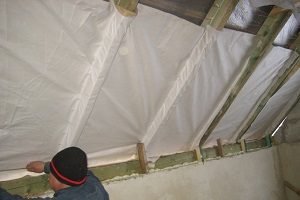
Usually, in this case, unpleasant moments are revealed that prevent the creation of the correct roof. This may be a big difference between the sides of the house or in the distance between the lags, due to which the building has received an irregular shape.
Therefore, to ensure proper thermal insulation of the roof, it is necessary to eliminate various structural defects in time. It is necessary to carry out the installation of the rafter system only after the evenness of the slope, as well as the roof ridge, has been achieved.
If this is not done, then in the future, so-called cold bridges will appear in the “roofing cake”, through which heat will leave the house. They are areas where the integrity of the insulation is broken.
It is important to know: when a lot of icicles begin to form on the roof in winter, this will mean that there are gaps in the insulation of the building, due to which the roof is heated by warm air and the snow melts on it.To eliminate this, you need to additionally insulate the roof with felt. A dry, and most importantly, warm roof is the key to a comfortable and cozy atmosphere in the house
At the same time, the insulation does not only keep the house warm in winter, but also allows you to keep cool inside it in the heat.
Dry, and most importantly, a warm roof is the key to a comfortable and cozy atmosphere in the house. At the same time, the insulation does not only keep the house warm in winter, but also allows you to keep cool inside it in the heat.
Watch the video in which the specialist explains in detail the nuances of warming the roof of the house:
Thermal insulation of the roof of a house is an essential moment in the construction or overhaul of the roof. The selection of the installation technology of the thermal insulation layer is subject to the combination of the roof, the type of insulation and recommendations that apply to the room located under the roof.

